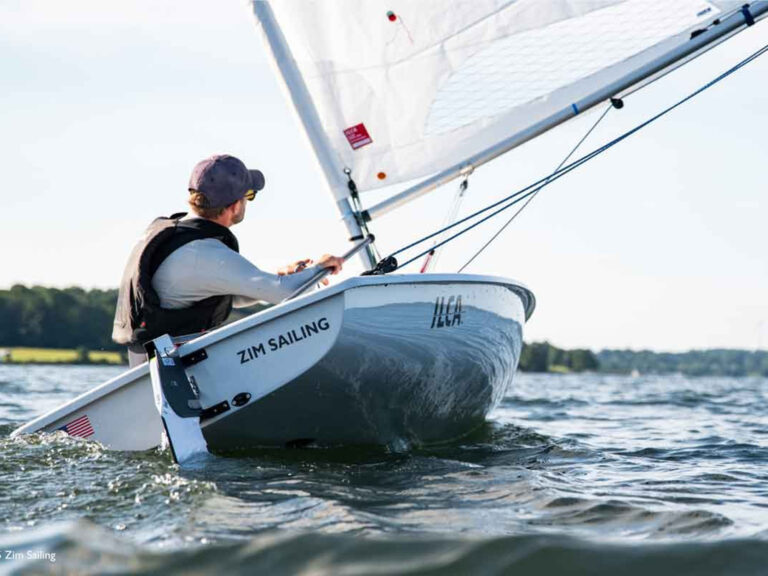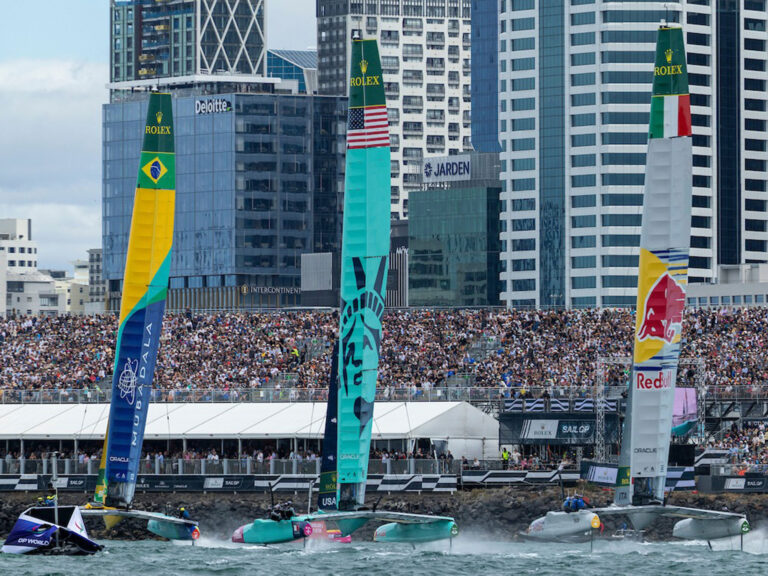
FBMoneypenny368b
Gavin Brady appeared concerned. He glanced at it one way, then took a few steps, and gave it a second look from his new perspective. He didn’t seem any happier. The object of his consternation was the mocked-up companionway aboard Jim Swartz’s new STT 65, Moneypenny, currently under construction at McConaghy Boats just north of Sydney, Australia. Brady will serve as Swartz’s tactician and offshore helmsman when the boat makes its U.S. debut next spring in New England in advance of the Newport-Bermuda Race, and he was in town a week ago along with several other key members of the campaign–Swartz, project managers Ken Keefe and Kimo Worthington, and navigator Mark Rudiger–to put final stamps of approval on hundreds of details as the build goes into its final stages.
But what was it, exactly, that had given Brady pause? “That main hatch,” he said. “I’m not sure it’s big enough.”
It was hard, at first, to see what he meant, but as he began to explain what was running through his mind, it was clear that he was already on the racecourse, working upwind, visualizing the possibilities. Moneypenny’s first regatta is six months away, on the other side of the planet, but for Brady, it wasn’t too early to start breaking down the scenarios.
“Even though this boat has a big keel on it, it also has a lot of sail area,” he said. “We’re going to be lacking stability nearly all of the time, so we’re going to be hiking. So we don’t want people struggling to get sails up and down hatches. We want the sail on deck and the guys back on the rail, hiking.”
“It’s all about speed around the course,” he continued. “I can imagine us in a pack of boats that we’re almost crossing. Then you see four guys struggling to pull a sail out of a hatch because it’s three inches too small. Next thing, you’re not crossing. Now you’re tacking to leeward and following them around the mark. And they’re still struggling to get the sail on deck! Now the spinnaker set is late. Now you’re four lengths, five lengths behind. It’s just a frustrating situation.”
He didn’t need to say anything else. His description had left me with a sinking feeling in the bottom of my stomach. As Brady talked, down below, in the open expanse of the recently completed but still-empty carbon hull, the rest of the Moneypenny brain trust was in all manner of deliberations. Swartz and Worthington were reaching overhead, searching for grab rails that have yet to be installed. Keefe and Rudiger were aft, musing over the parameters of the future nav station. Topside, Brady was still pacing, laying out his territory.
“Like the TP 52s, these (STT 65s) will be rewarding boats to sail if you sail them well,” he said. “They’re physical. If you’re pumping and catching waves, and your helmsman is concentrating and working with the trimmers, and the grinders are working and the bow guys are getting off the bow quickly, all these little things can make a really big difference. If you nail a jibe on an America’s Cup boat, you gain 15 meters. If you nail a jibe on one of these, you can gain four or five boat lengths. They tell you when you’re sailing well, and they tell you when you’re sailing poorly. I think it’s the direction the sport’s going.”
Swartz and his team were in the middle of a long week of talks and tinkering. Brady said it was an invaluable experience. “From my point of view, I’m thinking, ‘How is this boat going to help me tactically?’ Obviously, a fast boat makes a tactician look smart. So I don’t want too much stuff downstairs. I don’t want creature comforts. I want low windage. I want low weight. So someone else needs to be thinking about winch gear and mechanics, and how it’s going to work and function. It’s all about trade-offs, because you can’t have it all.”
Brady also said he was sensitive to Keefe’s position, as the overseer of the respective wish lists. “Ken’s thinking, ‘How can I get this thing out the door on time with all the ideas these guys are coming up with and the changes they want to make?'” said Brady.
“You’ve got to be careful that you don’t make too much of a dreamboat,” he added. “Realistically, the dreamboat is the one that comes out of the shed on time and on budget, so you can get out there and start sailing and learning how to sail it. You can sit here and add all the gadgets in the world but if it takes twelve months to build, and you miss that first regatta, and everything ends up behind schedule, you may never really catch up. You don’t want to be the boat, and the team, that had all the potential but didn’t quite achieve the goals.”
After awhile, Keefe and the others joined Brady on deck, listened to his thoughts, and asked McConaghy’s Jono Morris if, from a structural point of view, the main hatch could be widened. He didn’t think it’d be a problem.
Brady nodded approvingly, but a minute later, he and Swartz were in deep conversation just aft of one of Moneypenny’s twin wheels. There was something about crew weight downwind, and who’d be on the runners, and where would everyone hike on the runs?
The exercise continued, a bit of give here and a bit of take there, long into the Australian night.





